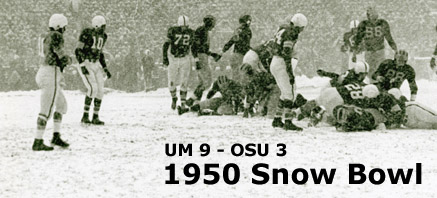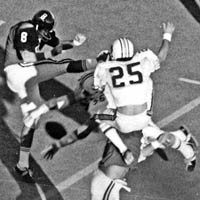|
Memorable
Football Games – VII
January 3, 1942: Tulane Stadium, New Orleans – East-West Shrine Game
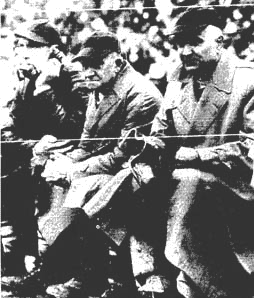
East coaches Bernie Bierman (right) of Minnesota and Andy Kerr (middle) of Colgate
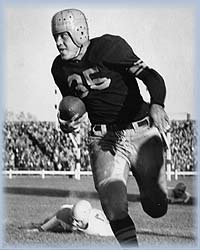
Bill Dudley
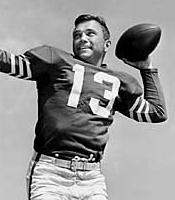
Frank Albert
Top of Page |
The Shrine game pitting senior all stars from the East against a like team from the West had been held in San Francisco since 1925.
- However, the contest following the 1941 season, like that year's Rose Bowl, was moved from California because of fear of Japanese attack on the U.S. mainland following Pearl Harbor.
- The displaced Shrine game was played at Tulane Stadium in New Orleans which, two days earlier, had hosted the annual Sugar Bowl between Fordham and Missouri.
- The Oregon State team attended the game, arriving by train on their way back to the West Coast two days after their Rose Bowl victory over Duke at Durham NC.
Art Cohn, sports editor of the Oakland Tribune, began his story on the game as follows.
We buried an old friend today. We watched the last football game of the season, perhaps the last of our generation, some 25,000 of us who huddled shivering in the cold and wet of a soulless day as dismal and dreary as sports' future. Below us, many of America's finest athletes soon to become her finest soldiers, wrote a postscript to an era while struggling to a 6-6 standstill in the seventeenth annual Shrine East-West game, held for the first time (and let us pray the last) outside San Francisco.
The East team, coached by Bernie Bierman of Minnesota, "conceded to be the country's most successful coach," was a 2-to-1 favorite.
- Bernie's team included All-Americans like guards Endicott Peabody of Harvard and Ralph Fife of Pittsburgh as well as backs Ralph Smith of Minnesota and Bill Dudley of Virginia.
- West coach D. E. "Babe" Hollingbery of Washington State countered with Bob Reinhard, California T, Frankie Albert, Stanford QB, and Mal Kutner, Texas E.
However, the weather severely hampered play. More from Cohn:
A torrential downpour that flooded the city shortly before noon, accompanied by an Arctic wind that sent the temperature tumbling to the thirties, utterly ruined all hopes of an anticipated crowd of 50,000, even as it wrecked all chances of a fast field. Thanks to the city's ignorance in not even providing a tarpaulin to protect the field against such a downpour, the gridiron was a bog.
The squads battled evenly throughout the four quarters, the East moving mostly on the ground while the West advanced by air.
- In Q1, Billy Sewell, "Washington State's magnificent passer," led a West drive to the East 19 only to be thwarted by a 15-yard holding penalty.
- The most exciting play of Q2 was Albert taking "a long lazy punt" from the toe of Bill De Correvont, Northwestern's ace and raced 43y to the East 32. However, the West again failed to take advantage of its opportunity. Sewell punted to the 2 and, after stuffing the East, the West got good field position at the 38. However, Dudley's interception pulled the East out of the hole. Bierman's boys then drove to the 9 before another interception, by Eso Naranche of Montana State, staved off a score in the last minute of the scoreless first half.
- Taking the second half kickoff, the East drove relentlessly behind the running and passing of FB Bob Westfall, who followed in the footsteps of his fellow Wolverine, Tom Harmon, the star of the previous Shrine game. The last 20 yards were navigated by Colgate's Bill Geyer on a screen pass from Dudley. Dudley's PAT kick was wide.
- The West bounced right back, driving to the 6. However, on third down, Sewell was trapped by 272-pound Urban Odson of Minnesota, when he couldn't find a receiver open. The 14yd loss ended that drive.
- On the next West possession, a pass-and-lateral from Sewell to Ken Casanega of Santa Clara (a high school teammate of Albert) to Kutner netted 28yd to the East 20. However, this thrust ended on the 11.
- Early in Q4, C Bradley Sheafe of St. Mary's recovered a fumble by Tulane's Bob Glass on the East 22. This time, the West was not to be denied. A 10yd pass from Jack Jacobs, "a Creek Indian from Utah," to Vike Francis of Nebraska was followed by Jacobs's touchdown toss to Bob Robertson of USC. Albert then tried his hand, or rather his foot, at kicking the PAT but Fife blocked it to preserve the tie.
To quote Cohn again: "That ended the scoring. That also ended the game. That may have ended football. At least, for a long, long time."
In his condescending article, Cohn took another swipe at the host city.
Although the turnout of some 20,000 cash customers and some 5000 deadheads was a tribute to the courage or insanity of Louisianans, it was a bitter disappointment to Shrine officials, who had been led to believe by local yokels that it would draw at least 50,000. Withal the Shrine Temples of San Francisco and Oakland, sponsors of the game for the benefit of the Shrine Hospital for Crippled Children, will not go into the red. The advance ticket sale of $33,000 cash here plus the generous amount of tickets sold in Northern California that were not turned back for refunds, will just about square accounts. It is still a miracle that the game was played at all. Neither war nor flood, wind nor mud could stop it. The Shriners had to battle a world crisis and the elements to keep their game alive. And they did. This was the greatest victory of all; this was the triumph that will live long after the physical details of today's game are but a forgotten memory.
Bierman, a major in the Marine Corps Reserve, was notified the morning of the game to report for duty at Quantico VA by January 15. When the war ended in 1945, he returned to Minnesota to coach until 1950. |
|
October 16, 1943: Baxter Bowl, Stockton CA – Del Monte Navy Pre-Flight @ College of the Pacific
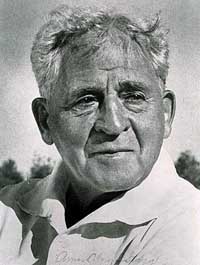
Amos Alonzo Stagg |
The College of the Pacific team carried their coach off the field after a shocking win. He hadn't smiled so broadly since he pitched Yale to a 6-5 victory over Harvard 57 years before. The coach was 81-year-old Amos Alonzo Stagg, who had come to Pacific (a Methodist school) in 1933 after falling victim to the University of Chicago's mandatory retirement rule for 70-year olds.
Stagg's Tigers had just upset Del Monte Pre-Flight 16-7. Del Monte, a Naval base on the Monterrey peninsula next to San Diego, featured an array of talented college and pro players that had led them to four victories in as many tries. Ex-Carnegie Tech coach Bill Kern boasted six former All-Americans.
|
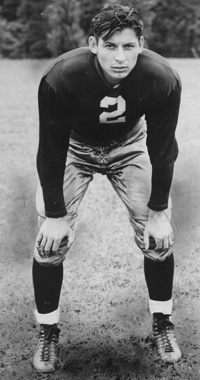
Len Eshmont |
- "Passing Paul" Christman, TB from Missouri
- HB Len Eshmont, the "Fordham Flash"
- HB-QB Jim McDonald of Ohio State and the Detroit Lions
- Parker Hall, another passer from Mississippi and the Cleveland Rams
- Ed Cifers, 225lb RE who was an All-American at Tennessee;
- Bowden Wyatt, LE and also an All-American from Ole Miss.
As a result, the Navy men were 5-to-1 favorites over the college boys. However, Stagg had some Navy trainees of his own, including:
- Passing ace Johnny Podesto and three of his backfield mates from St. Mary's.
- Dominating tackles Earl Klapstein and Art McCaffray from Santa Clara.
- Two other solid linemen, Bert Gianelli and Jim Watson.
After a scoreless first half, Pacific shoved over a touchdown in Q3 for a 7-0 lead on a 7yd run by Podesto. Galvanized, the Navigators answered back on an Eshmont run to tie at the beginning of Q4. But the Tigers immediately broke back in front, 14-7, on a 25yd pass from Podesto to Jack Hurley. Stagg's club clinched the win with less than two minutes left when the desperate Pre-Flighters threw an incomplete pass from behind their goal line, which was ruled in a safety in that era. |
 Paul Christman

Parker Hall
|
As a result of the victory, Pacific was mentioned as a contender for the national championship, particularly if they could get by USC in their next contest. Stagg might even get a chance to coach a Rose Bowl team for the first time. [Alas, it was not to be. The Trojans won 6-0, and Pacific finished 7-2.]
Because of wartime restrictions, the Old Man didn't get to celebrate the victory in his time-honored way by eating a quart of ice cream. Instead, he had to be content with a dish of fresh figs.
Reference: " Stagg's 54th," Time, October 25, 1943 | Top of Page |
December 3, 1949: Cotton Bowl, Dallas TX, Notre Dame @ Southern Methodist
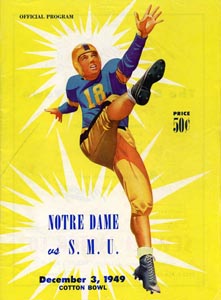

Doak Walker

Kyle Rote
.
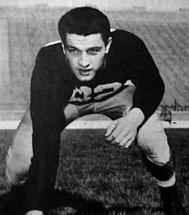
Leon Hart
Top of Page |
Going into the last game of the 1949 season, Frank Leahy's Notre Dame Fighting Irish had not lost a game in almost four full seasons. The 1945 squad, coached by Hugh Devore while Leahy served in the military, lost its final game 39-7 at the Great Lakes Naval Air Station. Then Leahy returned to post the following records.
- 1946: 8-0-1 with the famous 0-0 tie with Army in Yankee Stadium
- 1947: 9-0
- 1948: 9-0-1, the tie being with Southern Cal 14-14 in Los Angeles in the last game
- 1949: 9-0 including a 32-0 shellacking of USC in South Bend the week before the SMU finale [Watch footage of the USC game]
Understandably, the Irish were solid favorites – as many as 28 points in some betting lines – heading to Dallas. The Mustangs sported a 5-3-1 record and were coming off back-to-back losses to Baylor (35-26) and archrival TCU (21-13). Adding to coach Madison Bell's problems was the fact that a leg injury would sideline star TB Doak Walker in Bell's last game before retirement.
Walker's replacement, Kyle Rote, played the game of his life and nearly led the Mustangs to the upset of the season before a capacity crowd of 75,457. He "smashed and crashed" for 115yd on the ground and completed 10 of 24 passes for 146 yards. ND's QB Bob Williams, who had succeeded Heisman Trophy winner Johnny Lujack, connected on 11 of 18 for 165 yards, including two touchdowns.
- After nine scoreless minutes, ND broke through when Willliams hit a 42 yd touchdown to Bill Wightkin. Then came the most sensational play of the game. Rote handed to Johnny Champion who lofted a pass to John Milam who ran to the 6. However, the Irish held on downs at the one foot line.
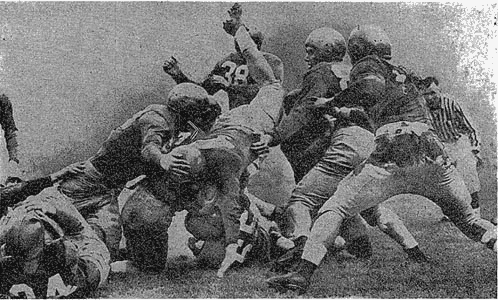
Rote stopped on one foot line
- Following an interception shortly before the half, Williams' pass was deflected into the hands of Ernie Zalejki for a touchdown. A missed PAT left the visitors ahead 13-0 at the break.
- SMU started moving the ball in Q3. Given a short field at the ND 47, Rote drove his team to the 3, where the powered into the end zone. Bill Sullivan's extra point made it 13-7.
- E Jim Mutscheller intercepted Rote at the SMU 22 to set up a 4yd touchdown run by Bill Barrett that stretched the lead back to 13.
- The final 15 minutes saw what the AP writer called "the gutsiest performance by a football player in the history of the game." Bell inserted Rusty Russell at QB, allowing Rote to move to HB. Russell handed to Rote who, with Irish keying on him, flipped the ball to Champion who caught it at the SMU 34 and raced to the Irish 1. Rote scored on the next play to bring the Mustangs back to a 6-point deficit.
- When the Irish were forced to punt on their next series, Billy Richards returned it to the ND 14. It took Rote only two plays to find the end zone for the third time. However, the extra point was blocked, leaving SMU tied with the #1 team in the land.
- Trying to blunt the home team's momentum, Leahy moved Hart from E to FB. The 260-pounder along with FB Emil Sitko battered the defense for 51 yards to set up Barrett's six-yard end sweep for the go ahead score – 27-20 Irish.
- Rote led a last desperate drive to the 28. Then he had to leave the game after a hit by Hart. Sophomore Fred Brenners replaced him and passed to H. N. Russell to the 5. Brenners was then put out of the game by Hart. Rote returned and ran to the 5. With less than four minutes left, facing fourth-and-goal, Rote's jump pass over the line to Champion in the end zone was intercepted. Notre Dame ran out the clock to preserve their streak. The victory was their tighest of the season, the previous closest game having been 34-21 vs Michigan State.
SMU's valiant effort caught the nation's attention. A nine-minute newsreel entitled "Football's Mighty Mustang" played in theaters around the country in 1950. Coach Bell noted: "It was the greatest effort I ever had a bunch of boys give." State sports writers voted Rote's performance that day as the best by a Texas athlete in the first half of the 20th century.
Immediately after the Dallas game, Leahy pronounced his '49 squad the "greatest I ever coached. It's got guts, it's got character." |
|
November 25, 1950: Ohio Stadium, Columbus OH – The Snow Bowl
Ohio State's final game of the 1950 season was one of the strangest in football annals. "The Great Thanksgiving Snowstorm" assailed Ohio a few days before the Buckeyes' annual game against Michigan.
Snowdrifts up to 29" and heavy winds made transportation dangerous, if not impossible. In fact, the Wolverines had a difficult time getting to Columbus. They took a special train to Toledo on Friday, then Saturday morning made it to Columbus, where the blizzard didn't hit until two hours before the 1 pm kickoff. The team had to walk the last half-mile to the stadium through knee-deep snow.
It was still uncertain as to whether the contest would be held. OSU Athletic Director Dick Larkins and coach Wes Fesler wanted to postpone the game because of the dangerous and unplayable conditions. However, Michigan Athletic Director Fritz Crisler told Larkins, "We're here now. We're not coming back."
An attempt was made to contact Big Nine Conference Commissioner Tug Wilson, but he was attending another game and unavailable. (The conference was the Big Nine because Chicago had dropped out and Michigan State had not yet been invited.)
Michigan had made it to Ohio Stadium; all the tickets were sold and refunding money would be a mess; no Big Ten game had ever been cancelled. So why not play? Also, the Rose Bowl invitation was on the line. When Fesler found out the game would go on, he protested, "This is crazy!"
Interestingly, if the game were not played, Ohio State would be given the nod on the basis of its 4-1 conference record as opposed to the Wolverines' 3-1-1. However, because of the No-Repeat Rule, the Buckeyes could not return to the Rose Bowl.
It took several hours to clear the snow. However, kickoff was 20 minutes late because the grounds crew could not remove one of the tarpaulins that was frozen to the field. The game finally began in 10-degree weather and dropped to 5° with winds up to 40 mph.
For one of the few times in this great series, there were many empty seats. The attendance is given as 50,503, most of whom waited under the stadium until just minutes before kickoff.
As you can imagine, the offenses struggled.
"The snow, wind, and insecure footing made the game a mockery – an imitation of football only by a stretch of the imagination. The two teams huffed, puffed, bumped and slid. Cold hands refused to hang on to the ball."
All the players wore gloves. Some changed into tennis shoes at halftime to get better traction. The ball was often blown away after placement on the line of scrimmage.
Volunteers formed a broom detail, sweeping the goal lines and sideline yard markers clean throughout the contest. On several occasions, when an official called time to measure for a first down, sweepers cleared off the snow to find the line. At times, players had trouble seeing each other through the snow, which fell horizontally and stung the faces of those in attendance.
The conditions dictated the strategy that both teams followed: Run a play or two straight into the line, then kick, preferably on third down because if a fumble occurred on fourth down, the opponent would gain great field position. As a result, there were 45 punts, some even on first down several times when deep in their own territory.
Michigan did not complete a pass and never made a first down. Yet the Wolverines won the game. Here's how.
Ohio State scored first on a field goal by its do-everything junior HB Vic Janowicz. The score was set up when Bob Momsen blocked a Wolverine first down punt from inside its 10 that Joe Campanella recovered on the two. After going backwards for three downs, Janowicz grabbed a broom from an official and cleared out a spot at the 28y line. Fans strained to watch his 38y attempt. Incredibly, he put the ball through the uprights, an accomplishment that some call "one of the most remarkable feats in college football history."
Later in the first quarter, the Wolverines gained a safety by blocking a kick out of the end zone. In the second period, Michigan got close enough to try a field goal but missed.
Then, with 47 seconds left in the half, Fesler decided to punt rather than run out the clock. UM's Tony Momsen, Buckeye Bob's brother, blocked Janowicz's boot and fell on the ball.
After digging through the snow to find the yard markers, the officials determined the recovery occurred in the end zone. Touchdown, Michigan!
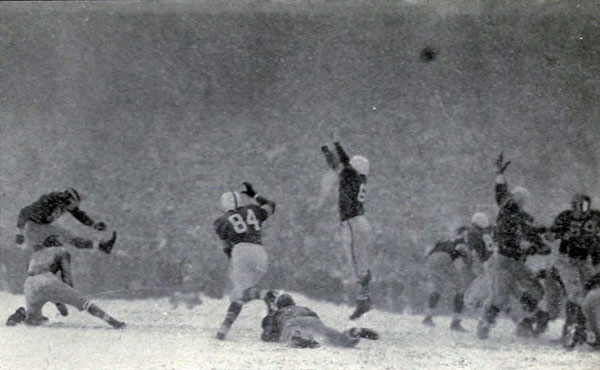
Harry Allis kicks the PAT for Michigan to make it 9-3 After a disspirited and scoreless second half, Michigan won 9-3 in what quickly came to be known as the "Snow Bowl."
The Wolverines hoisted Coach Bennie Oosterbahn onto their shoulders. When they learned that Northwestern upset Illinois, UM made plans to play in the Rose Bowl in sunny California.
The teams combined for only 68y of offense, 41 by Ohio State to 27 for UM. Michigan misfired on nine pass attempts while OSU completed 3-of-18 for 25y. The Buckeyes earned three first downs. The Wolverines fumbled six times, and the Bucks, four but each side lost only one.
OSU radio announcer Marv Homan recalled: "After the game, officials went through the stands looking to make sure no one had succumbed to the conditions. It would have been easy for someone who had too much to drink to pass out and get covered up by the snow. No one would have noticed for a few days. It was scary, and they were very concerned about that."
|
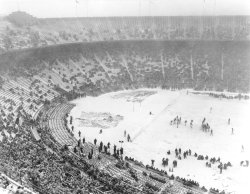

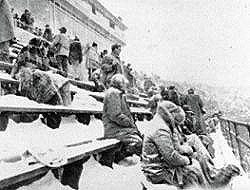
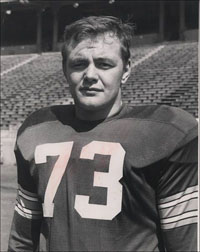
Bob Momsen
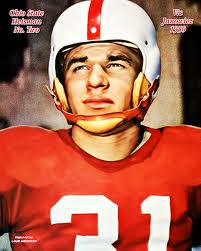
Vic Janowicz
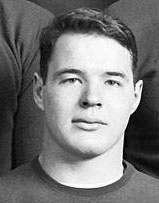
Tony Momsen
|
The players remembered the game years later. Momsen: "Most people said those were the worst conditions that any college football game was ever played in. I know they had a heckuva time getting the tarp off the field. The fans helped, but they only got about half of it off because the rest was stuck under snow and ice. Janowicz kicked that 26y field goal against a 35mph wind, and nobody knew if he'd made it until we heard the crowd."
Janowicz: "It was like a nightmare. My hands were numb (and blue). I had no feeling in them. and I don't know how I hung onto the ball. It was terrible. You knew what you wanted to do, but you couldn't do it."
Janowicz won the Heisman Trophy for 1950, partly because of his fantastic field goal in the snow and wind.
Michigan defeated California 14-6 in the Rose Bowl.
Fesler unexpectedly resigned after compiling a 21-13-3 record in four years. Part of his reason was the heat he received for losing to Michigan for the third time in four years - the other being a tie. The fans didn't cut him any slack because of the weather in the Snow Bowl, especially because of his "bonehead" decision to punt in the last minute of the first half.
He was replaced by Woody Hayes. Thus began the greatest era of Buckeye football.
View footage of the game
Reference: Highlights of College Football, John Durant and Les Etter (1970)
Football Feuds: The Greatest College Football Rivalries, Ken Rappoport & Barry Wilner
Blood, Sweat and Cheers: Great Football Rivalries of the Big Ten, Todd Mishler (2007)
Buckeye Glory Days: The Most Memorable Games of Ohio State Football, Eric Kaelin (2004)
Top of Page |
October 24, 1965: Kansas City Chiefs @ Houston Oilers
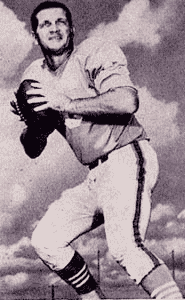
George Blanda
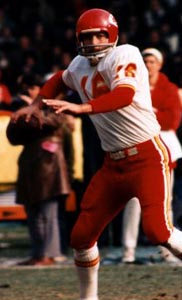
Len Dawson
Top of Page |
The Houston Oilers were the premiere club in the first years of the American Football League.
- Bud Adams' team won the first two championship games in 1960-1 and lost in the third final.
- Houston then dropped to 6-8 in 1963 and 4-10 in 1964.
When the Kansas City Chiefs came to town in 1965, the Oilers were mired in a three-game losing streak.
- The fans at Jeppesen Stadium had vented much of their ire on 38-year-old QB George Blanda, the only starter in Oilers' history to that point. Coach Hugh Taylor decided to start Don Trull.
- On the other side, KC coach Hank Stram replaced his starter Len Dawson with a younger man, Pete Beathard.
Stram's change worked; Taylor's didn't.
- At halftime, the Chiefs led 17-0.
- The Oilers coaches told Blanda at halftime that he would start the second frame.
- A long chorus of boss greeted George the first time he trotted into the huddle.
- Irritated, Blanda decided to let it fly on the first play. "I wanted to throw it right down some of those big mouths." 66y later TE Charlie Frazier crossed the goal line for Houston's first points.
After his defense held, Blanda took the field again.
- After one line plunge, he hit Ode Burrell in the flat for a 49y touchdown. 17-14 KC.
- After another defensive stand, Blanda decided to advance in smaller chunks. He culminated the drive by hitting Frazier for 17y and the lead.
- Bang, bang, bang. Three touchdowns in four minutes. Yet the beat went on.
- The fired-up D held again, and Blanda marched his troops to another touchdown, a 9-yarder to Frazier.
At that point, Stram sent Dawson into the game to regain the momentum.
- The cool veteran got his O moving again and narrowed the score with a 29yd field goal early in Q4.
- However, the D still couldn't stop Blanda and company. A 9y pass to Bob McLeod propelled the home team to a 35-20 lead. Naturally, the crowd had by now turned into cheering maniacs.
But Dawson wouldn't concede the battle.
- He hit FB Curtis McClinton on a swing pass for a 40y touchdown.
- Down 15, the Chiefs went for two. Dawson rolled out and threw to Jerrell Wilson for the two-point conversion. 35-28 Houston with 7 minutes to play.
As Blanda later admitted, Houston got conservative too soon.
- Three and out gave KC the ball back, and Dawson hit Otis Taylor from the 8 to pull within one.
- Stram decided to go for two again and succeeded when Beathard ran in. The scoreboard clock showed 1:20 left.
After a good kickoff return to the Oiler 40, Blanda noticed the safeties "playing so deep they were almost offside for next Sunday's game."
- He swung one to FB Charlie Tolar for 17. He hit Burrell for six, then Tolar again for 12. First down on the 27 ? within field goal range.
- But Blanda wasn't satisfied. He hit Frazier on a curl pattern to the 9.
- With 17 seconds left, Jack Spikes trotted out and booted the winner: 38-36.
As he walked off the field, Blanda thought: "I could hang it up right here and never have a more satisfying moment ..."
- He also got great satisfaction in serving a big helping of crow to the 34,670 fans who had been yelling for his scalp.
- Of course, George didn't hang it up and played one more year with Houston and nine with the Oakland Raiders.
- The Pro Football Hall of Fame welcomed him in 1981.
|
Reference: The Football Game I'll Never Forget, Chris McDonell
|
December 6, 1969: Texas @ Arkansas and January 1, 1970: Cotton Bowl - Texas vs Notre Dame
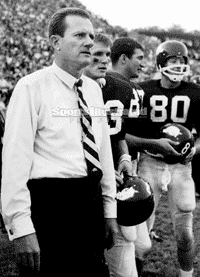
Frank Broyles
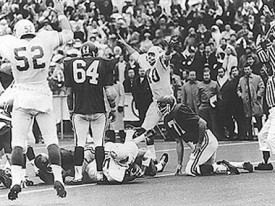
Jim Bertelson scores the tying touchdown

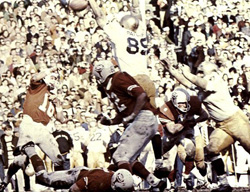
James Street in the Cotton Bowl
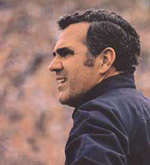
Ara Parshegian
Top of Page |
This clash between #1 Texas and #2 Arkansas is #9 on ESPN's 100 Moments That Have Defined College Football.
Both teams were 9-0 and led by Hall of Fame coaches - Darrell Royal for Texas, which had won 18 in a row, and Frank Broyles for Arkansas.
- The game in Fayetteville would decide the Southwest Conference championship and a berth in the Cotton Bowl as well as clinching the top spot in the final regular season AP poll.
- ABC TV executive Beano Cook had had the foresight before the season began to move the game from its October date to the first week of December.
- Another concession to TV was that the game began at noon local time to make sure it finished before dusk since Arkansas did not yet have lights on its field.
The game attracted dignitaries.
- Evangelist Billy Graham gave the pregame prayer.
- President Richard Nixon flew in from Washington. Since the area didn't include an airport big enough for Air Force One, the president made the last leg of the journey via helicopter. Marine One landed on the practice field outside the stadium just as the game began. Nixon brought with him a plaque he would award to the winning team as national champion.
- Congressmen George H.W. Bush of Texas and John Paul Hammerschmidt of Arkansas accompanied the president.
Thanks to six Texas turnovers, the Razorbacks led 14-0 after three quarters.
- But Longhorn QB James Street scrambled 42y for a touchdown on the first play of the final period.
- Royal had decided before the game to go for two after the first touchdown so as to avoid a tie. Street dove over to make the score 14-8.
- QB Bill Montgomery then led the Razorbacks on a 73y drive to the seven.
- However, Danny Lester intercepted a pass in the end zone.
- A field goal would likely have put the game out of reach.
Texas began a drive that reached fourth-and-3 from its own 43 with 4:47 left.
- During the timeout, Royal told Street, "Right 53 Veer pass." The play was a deep pattern to the TE.
- Since the play wasn't in the game plan package, Street asked, "Are you sure that's the call you want?" "Damn right I'm sure!" Royal snapped.
- Street had noticed Arkansas defenders looking into the Texas huddle. So he looked at SE Cotton Speyrer while explaining the play to TE Randy Peschel.
- Peschel then made a difficult catch over his shoulder in double coverage for 44y to the 13. Two plays later, Jim Bertelson plunged over.
- Happy Feller kicked the go-ahead point despite a high snap.
- With 3:58 left, Arkansas had a chance to set up the winning field goal. They reached the Longhorn 40 when an interception ended their hopes.
- The victory gave Street a 19-0 record as a starter.
As promised, President Nixon came to the winning locker room and presented a "national championship" plaque.
- This action did not sit well in the state of Pennsylvania where Joe Paterno's Penn State Nittany Lions had completed their second straight undefeated season and thought they should play Texas in the Cotton Bowl for the national championship.
- The Dallas bowl might have scheduled that game except for a surprise development.
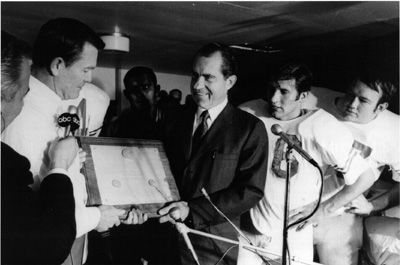
President Nixon presenting national championship plaque to Darrell Royal
Video highlights of Texas-Arkansas
He and the other Longhorns were flabbergasted by the opponent selected to face them in the Cotton Bowl.
- #9 Notre Dame (8-1-1) decided to reverse its 44-year policy of not participating in bowl games.
- This presented a problem for Street, who was raised Catholic. When he called his mom and told her Texas was playing Notre Dame, there was silence on the other end.
- So he said, "Hey Mom. This is your son talking. You're pulling for me. You're not pulling for Notre Dame."
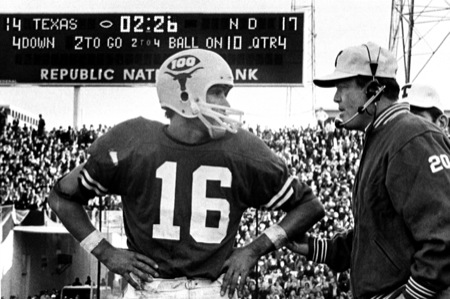
Street and Royal during the Cotton Bowl
Texas defeated Ara Parseghian's Irish 21-17.
- Street led a 17-play, 76y drive for the winning touchdown to finish his QB career undefeated.
- As in the Arkansas game, the Longhorns had to convert several fourth downs, the last one on the 10 with two to go for the first.
- Street told the huddle: "For some of us, this could be the last play of our career. Let's make damn sure it's a good one."
- He almost botched the play as he slipped coming out from under C. As a result, he had to hurry a pass to Speyrer who made a diving catch at the two.
- Texas then scored to take the lead with 1:03 left.
Since college football was celebrating its centennial in 1969, a Dallas reporter wrote after the Cotton Bowl: "The initial temptation would be to rank the Texas-Arkansas game as tops for the first 100 years of college football, and then start the second centennial running with this one."
Video of the fourth down Street-Speyrer pass
Reference: "Bowl Hero," Sporting News 12/22/2008
|
|
October 10, 1970 – Los Angeles Memorial Coliseum: Oregon @ UCLA
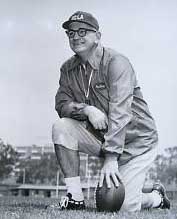
Tommy Prothro
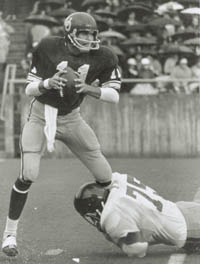
Dan Fouts, Oregon QB
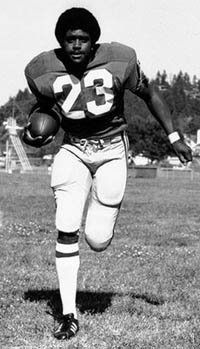
Bobby Moore
|
Tommy Prothro's UCLA Bruins had a week to lick their wounds after losing at Texas on a desperation pass from Eddie Phillips to Cotton Speyrer with 0:12 left, 20-17. The loss to the #2 Longhorns was UCLA's first after three victories.
Oregon came to the Coliseum with a 2-2 mark.
- Head coach Jerry Frei had assembled an impressive staff that included O coordinator John Robinson (future coach of USC and the LA Rams) and D backs coach George Seifert (later winner of a Super Bowl with the 49ers).
- Robinson built his game plans around sophomore QB Dan Fouts and junior TB Bobby Moore (later to be known in the NFL and as a sportscaster as Ahmad Rashad).
Oregon jumped out 21-10 in Q2 as Fouts surprisingly ran for two touchdowns and Moore romped 15y for another.
- UCLA had jumped on top on a 62y gallop by TB Marv Kendricks.
- Then Bruin senior QB Dennis Dummit got hot. He led a drive that culminated on his 1y sneak before the half, then threw a 31y touchdown to Gary Campbell for a 26-21 lead in Q3.
Fouts' fumble at the Bruin one ended the potential go-ahead drive.
- Dummit then took his squad on a 96y march that ended with a 26y pass to Terry Vernoy.
- When Dennis threw another touchdown to Campbell for 15y, the home team led 40-21 with only 4:38 left.
- Later Frei said of the Bruin signal-caller: "He's not the best QB I've seen this year. But there were periods when he was the best QB I've ever seen."
- At this point, Frei decided to pull Fouts and replace him with senior captain Tom Blanchard, whose knee injury had opened the door for Fouts. (Blanchard was drafted by the Saints as a punter.)
33 seconds after Tom entered the fray, he passed 29y to Moore to cut the margin to 40-28 with four minutes to go.
- Confident the game was his when UCLA recovered the onsides kick, Prothro sent in his backup, Jim Nader. "We thought we had the game won and weren't going to throw anyway."
- Nader fumbled his third snap, and the Ducks recovered at the Bruins' 40.
- On the second play of his second possession, Blanchard isolated Moore on a LB and hit him for a 40y pass-and-run touchdown. 40-35 with 2:10 left.
- The Bruin fans who hadn't left early to beat the traffic with the game well in hand felt deja vu all over again.
Oregon recovered the next onsides kick.
- But, on the second play, Blanchard separated his shoulder while throwing a block on Moore's run.
- However, Tom stayed in and, on third down, threw one up for grabs to the 11 for Leland Grass. Defender Jerry Jaso came down with the ball along with Grass.
- Officials ruled a completion because of simultaneous possession. Blanchard took himself out at that point. "It's gone ... my shoulder," he told Frei. Back in went Fouts.
- Moore carried to the five. Then LB Rob Scribner sacked Fouts back to the 15 with under a minute remaining.
- As Fouts took the snap, he saw the LB drift over to help on Moore. This left TE Greg Specht open over the middle to take Fouts' bullet in the end zone with 0:30 left.
- When the two-point run failed, Oregon led 41-40.
Dummit had one last chance, but his Hail Mary on the last play was intercepted to seal UCLA's second straight loss in the last 20 seconds. "I've never seen one like it," said Prothro.
|
Reference: Heart Stoppers and Hail Marys, Ted Mandell | Top of Page
|
December 2, 1972: Auburn vs Alabama
The 1972 Iron Bowl pitted 10-0 Alabama, riding a 21-game winning streak, against 8-1 Auburn. Bear Bryant's Tide were ranked #2 behind USC while Shug Jordan's Tigers sat at #9 in the AP poll. Oddsmakers installed Bama as a 16-point favorite. During the week of the game, Bryant proclaimed, "I'd rather beat that cow college than beat Texas ten times," referring to the fact that he had already accepted an invitation to play in the Cotton Bowl for a chance to end his five-game bowl losing streak.
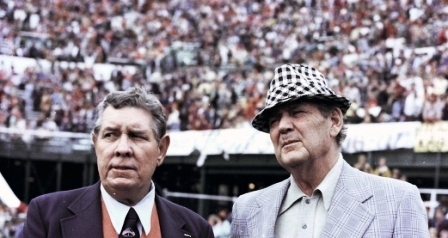
Shug Jordan and Bear Bryant
- A 3 yd run by Steve Bisceglia capped a 71-yard drive in the second quarter. However, DB Roger Mitchell blocked Bill Davis' PAT – a crucial play as it turned out and not the last blocked kick of the game.
- The Tide defense, which held Auburn to one first down in the first half, set up the next score when Lanny Norris returned an interception to the Tiger 13. However, the defense rose up and help Bama to a 14y field goal by Davis. 9-0 at halftime.
- Early in the third quarter, Wilbur Jackson scored from the 6 beind the blocking of John Hannah to increase the lead to 16-0.
- With Auburn mustering no O – it was held to 80 yd for the entire game – chances of a Tiger comeback seemed dim to non-existent. Not even an interception by David Langner at the Tide 35 in the first half brought points because of a bad snap on a field goal attempt.
Auburn finally got on the board in the fourth quarter.
- After Greg Gantt missed a 50-yd field goal attempt at the end of the third period, Jordan's boys finally put together a six-minute drive that resulted in a 42-yd field goal by Gardner Jett with 9:15 left. Jordan said later: "I remember the crowd booing when we went for the field goal. We went for the field goal to create enthusiasm. We had some but we needed more."
- Alabama consumed three and a half minutes on its next drive but had to punt from midfield. Gantt's last punt had gone 72y. But this one was blocked backwards by LB Bill Newton. The ball bounced right into the hands of Langner who scampered into the end zone. With 5:30 to play, Auburn had reduced the lead to 16-10.
- On its next possession, Bama got two first downs but again had to punt from its own 43. The next play would show that "lightning never strikes twice" does have exceptions. Amazingly, Newton again roared through and blocked Gantt's punt. And, again, the ball bounced right to Langner who raced 20y for the tying touchdown. Jett kicked the PAT to give Auburn an improbable 17-16 lead with only 1:34 remaining.
- Having no passing attack, the Tide desperately tried to get into field goal range. But Langner struck again with his second interception with 0:55 left.
Bryant took responsibility for what happened in the fourth quarter. "I've always said, and I mean this sincerely, that mistakes are head coaching. And of course, you saw what happened out there. The best coached team won. I did a lousy job."
The game, known forever as "Punt, 'Bama, Punt," turned out to be Alabama's only SEC loss from 1971-4. It was also Auburn's last Iron Bowl victory until 1982 in The Bear's last regular-season game as head coach.
|
|
|
December 21, 1984: Holiday Bowl Brigham Young vs Michigan
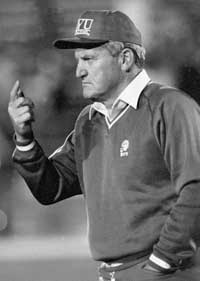
LaVell Edwards
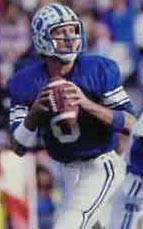
Robbie Bosco
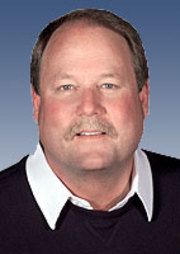
Mike Holmgren
|
The Brigham Young Cougars finished the 1984 regular season ranked #1 in the AP poll with a 12-0 record and a Western Athletic Conference (WAC) championship.
- Their non-conference victories came at Pittsburgh and at home against Tulsa and Baylor.
- In those pre-BCS days, the WAC champion played in the Holiday Bowl in San Diego against an at-large team. The selected opponent was the Michigan Wolverines.
Bo Schembechler's 16th UM squad was his first to lose five regular season games.
- This put BYU in a no-win situation in the minds of many sports writers and fans.
- Even a solid victory over the Big Ten's sixth-place team would not convince skeptics that the Cougars deserved the National Championship, which at that time was synonymous with the #1 ranking in the final AP poll.
Robbie Bosco was the QB for LaVell Edwards' Cougars.
- He had followed Jim McMahon and Steve Young under C.
- He proved to be the key player in the Holiday Bowl, despite being carried off the field in Q1 after a roughing the passer penalty resulted in a knee ligament strain.
I got hurt in the first quarter, injured my ankle, and I went into the locker room. It was one of those things where I wanted to hurry and get out there ... so I said, "Tape me up, and let's go."
I started warming up, and I'm like, "I can't do this, I can't drop back." I felt like if I could get into the game and get some adrenaline going, I might be OK. I said, "I'm ready to go in." Mike Holmgren [BYU's QB coach] ... said, "Are you sure?" He put me back in and implemented, on the spur of the moment, the shotgun, which we hadn't used all year. I wouldn't have to drop back as much.
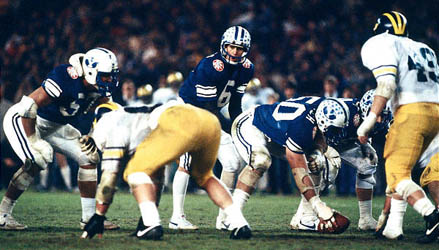
Robbie Bosco under C vs Michigan
After a scoreless opening stanza, Bosco returned to lead a drive that ended on a touchdown run by Kelly Smith at 8:33.
- Robbie completed several passes and also scrambled for a first down.
- BYU blew a scoring chance when, after the UM punter was tackled on the 5, Bosco fumbled into the endzone for a touchback.
- The Wolverines then drove for a touchdown aided by an unsportsmanlike penalty and then a running into the kicker penalty on a field goal that Bo took off the board for the first down.
- Rick Rodgers scored on a 5y run to tie the game. Running the two-minute drill, BYU kicked a field goal with 0:04 left to take a 10-7 halftime lead.
Michigan went ahead 14-10 lead late in Q3 on a touchdown pass from Chris Zurrburgg to Bob Perryman.
- Then return specialist Vi Sikahema fumbled the ensuing KO and was tackled at the 5.
- BYU fumbled a few plays later – its fifth turnover – and UM recovered at the 10 with 0:06 left in the quarter.
- BYU's D forced Michigan to settle for a field goal and a 17-10 lead.
This set the stage for another Cougar Holiday Bowl comeback as in 1980 and 1983.
- Bosco threw a 7y touchdown pass to Glenn Kozlowski with 10:51 remaining to tie the game.
- After a punt, Bosco threw another interception off the hands of Kozlowski. However, UM did nothing with the ball and had to punt.
With a little more than a couple minutes left in the game, we knew we had to be precise. Bottom line: We just wanted to get into field goal range. But deep in my mind was, "You never can count on that. If we can score, let's score." The team was behind that.
From the 13 with 1:23, Bosco passed to Smith in the back of the end zone for the go-ahead touchdown.
On our last play, we were just trying to throw an option route to our HB Kelly Smith. I had to step up in the pocket and try to avoid being sacked. Then Kelly broke toward the end zone and I saw him out of the corner of my eye. I made the pass, and he caught.
Marv Allen sealed the victory with an interception. The Cougars outgained their Big Ten opponent 184 to -5 in Q4. Bosco finished 30-42/343y.
Any time you win, everything feels better. My ankle swelled up pretty good once I got the tape off. It was an emotional season and a fitting end.
Edwards after the game: If you're number one going in, you're number one coming out. Anybody that saw us win tonight, the way we won with such adversity, knows we earned it.
BYU had to wait more than a week for the remaining bowl games to be played and the final poll to be compiled.
- Both the AP and UPI/Coaches' polls put them at the top.
- Thus 1984 marks the only time that the eventual national champion played its bowl game before New Year's Eve.
|
|
November 1, 1986: Auburn @ Florida Scorned Kicker Gets Revenge
Pat Dye's #5 Auburn Tigers invaded Gainesville with a 7-0 record, having outscored opponents 273-53.
- Galen Hall's Florida Gators were only 3-4, the victories coming over Georgia Southern, Kent State, and Rutgers – hardly top-notch competition.
- One reason for UF's struggles was the knee injury that had caused junior QB Kerwin Bell to miss the last two games.
No one gave the Gators much of a chance. And for three quarters, it looked like Auburn would have no trouble remaining undefeated.
- Florida turned the ball over six times in the first two quarters as southpaw Rodney Brewer was only 1-6 with two interceptions. He also fumbled twice. Hall finally sent in the gimpy Bell with 5:27 remaining in the half.
- At first, Kerwin had no better luck. He was picked off on his first series. Then in the third quarter, another interception set up a 31-yard Chris Knapp field goal to make the score 17-0.
- Bell finally got it going in the final quarter. Completing five of six, he marched UF 79 yd to cut the lead to 17-7 with 12:09 left.
- The Tiger offense cooperated by going three-and-out. Bell then led his team to the Auburn 24. However, Bell was sacked for an 11-yd loss. At that point, Hall sent in K Robert McGinty to try a 51-yard field goal. McGinty had transferred from Auburn after he missed a 42-yd field goal in the final seconds in a 17-15 loss to Alabama in 1984. After sitting out a year, he now had a chance to wound his former team. He connected with 7:10 left to make it 17-10.
- Auburn responded by controlling the ball for five minutes. But FB Reggie Ware fumbled and Florida recovered on its 36 with two minutes left.
- A facemask penalty moved the ball to the Auburn 49. A few plays later, from the 30, Bell lofted a pass down the sideline that WR Ricky Nattiel snared on the five with a minute to play.
- After an incompletion, Bell threw to Nattiel in the corner of the end zone to cut the lead to one, 17-16, with 9:36 left.
Hall's decision on what to do next was a no-brainer. His Gators were 0-3 in the SEC. A tie wouldn't do them much good.
- Nattiel was one of three receivers sent to the right as Florida lined up to go for two. "I was supposed to do whatever it took to get myself free," said Ricky.
- However, Auburn knew what the Gators wanted to do and covered Nattiel closely. Knowing Bell didn't run much even when he was healthy, the Tigers didn't rush him hard.
- When Bell couldn't find a receiver, he decided to run. He made it across the goal line just before LB Edward Phillips arrived.
- The entire Gator team ran on the field. For this, Florida was penalized 15 yd on the ensuing kickoff for unsportsmanlike conduct. As a result, Auburn had the ball on the UF 49 after the kickoff.
- The Tigers moved to the 36 with :06 remaining. Knapp, Dye's choice to replace McGinty, tried a 53 yd field goal into the wind. It fell short.
Florida rallied to finish the season 6-5. Auburn lost again two weeks later to Georgia to finish 4-2 in the SEC, one game behind champion LSU. Bell went on to set the career passing record for the SEC with 7,585 yd through 1987.
Reference: Heart Stoppers and Hail Marys, Ted Mandell | Top of Page
|
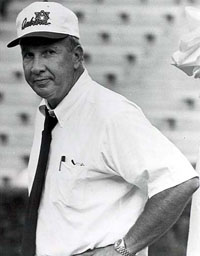
Pat Dye

Galen Hall
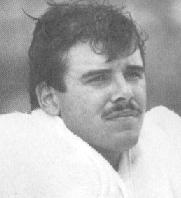
Kerwin Bell

Ricky Nattiel
|
|
CONTENTS
1942: East-West Shrine Game
1943: Del Monte Pre-Flight @ Pacific
1949: Notre Dame @ SMU
1950: The Snow Bowl
1965: Chiefs @ Oilers
1969: Texas @ Arkansas
1970: Oregon @ UCLA
1972: Auburn vs Alabama
1984: Holiday Bowl
1986: Auburn @ Florida
Memorable
Football Games Index
Football Magazine
Golden Rankings
Home
|














